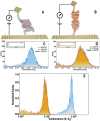Single-Molecule Electrical Conductance in Z-form DNA:RNA
- PMID: 39696933
- PMCID: PMC11798349
- DOI: 10.1002/smll.202408459
Single-Molecule Electrical Conductance in Z-form DNA:RNA
Abstract
Nucleic acids have emerged as new materials with promising applications in nanotechnology, molecular electronics, and biosensing, but their electronic properties, especially at the single-molecule level, are largely underexplored. The Z-form is an exotic left-handed helical oligonucleotide conformation that may be involved in critical biological processes such as the regulation of gene expression and epigenetic processes. In this work, the electrical conductance of individual Guanine Cytosine (GC)-rich DNA:RNA molecules is measured in physiological buffer and 2,2,2-Trifluoroethanol (TFE) solvent, corresponding to the natural (right-handed helix) A-form typical in DNA:RNA hybrids and the (left-handed) Z-form conformations, respectively. Single-molecule conductance measurements are performed using the Scanning Tunneling Microscopy (STM)-assisted break-junction method in the so-called "blinking" approach, recording the spontaneous formation of single-biomolecule junctions and performing statistical analysis of the signals. Circular Dichroism (CD) experiments and ab initio calculations are also done to rationalize the measured molecular conductivity with a simple structural and electronic model. These results show that the electrical conductivity of the Z-form is one order of magnitude lower than that of the more compact A-form. The longer molecular length and higher energy for the Highest Occupied Molecular Orbital (HOMO) of the Z-form account for the differences in single-molecule conductance observed experimentally.
Keywords: DFT; DNA:RNA; STM; Z‐form; biomolecular electronics; biophysics; circular dichroism; molecular electronics; nanoscience; single‐molecule conductance; solvent interactions.
© 2024 The Author(s). Small published by Wiley‐VCH GmbH.
Conflict of interest statement
The authors declare no conflict of interest.
Figures


References
MeSH terms
Substances
Grants and funding
LinkOut - more resources
Full Text Sources
Miscellaneous

